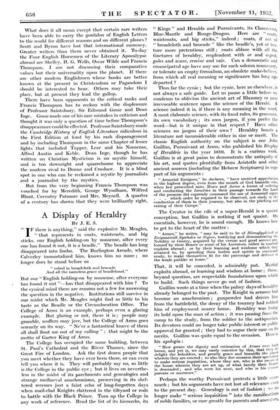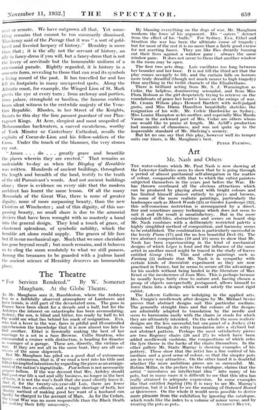A Display of Heraldry BY J. E. S.
" IF there is anything," said the explosive Mr. Meagles, 1 " that represents in coats, waistcoats, and big sticks, our English holding-on by nonsense, after every one has found it out, it is a beadle." The beadle has long disappeared into limbo. The Burlington Arcade, where Calverley immortalized him, knows him no more; no longer does he stand before us
" robed in broadcloth and brocade And all the nameless grace of beadlehood."
But our "English holding-on by nonsense, after everyone • has found it out "—has that disappeared with him ? To the cynical mind there are reasons not a few for answering the question in the negative. Institutions still survive in our midst which kr. Meagles might find as little to his taste as the Beadle or the Circumlocution Office. The College of Arms is an example, perhaps even a glaring example. But glaring or not, there it is ; people may grumble, scoffers may jeer, but the College of Arms goes serenely on its way. " Ne'er a fantastical knave of them all shall flout me out of my calling " : that might be the motto of Garter King of Arms.
The College has occupied the same building, between St. Paul's Cathedral and the River Thames, since the Great Fire of London. Ask the first dozen people that you meet whether they have ever been there, or can even tell you where it is. They will probably say no, so little is the College in the public eye ; but it lives on neverthe- less in the midst of its parchments and genealogies and strange mediaeval anachronisms, preserving in its shel- tered recesses just a faint echo of long-forgotten days when mail-clad Knights clattered in the tiltyard or rode to battle with the Black Prince. Turn up the College in any work of reference. Read the list of its hierarchs, its " Kings " and Heralds and Pursuivants, its _Clarenceux, Blue-Mantle and Rouge-Dragon. Here are " coats, waistcoats, and big sticks," indeed ; coats, if not of " broadcloth and brocade " like the beadle's, yet of rex. ture more pretentious still ; coats ablaze with all the tinctures of heraldry, resplendent with or and argent, gules and azure, ermine and vair. Cana democratic and emancipated age have any use for such solemn mummery, or tolerate an empty formalism, an obsolete make-believe, from which all real meaning or significance has long ago departed ?
Thus far the cynic ; but the cynic, here as elsewhere, is not always a safe guide. Let us pause a little before we condemn to oblivion the ancient art of Blazonry or pass irrevocable sentence upon the science of the Herald. A science indeed it is, if there is any meaning in the word. A most elaborate science, with its fixed rules, its grammar, its own vocabulary ; its own jargon, if you prefer the word—but is it unique in that respect ? Have other sciences no jargon of their own ? Heraldry boasts a literature not inconsiderable either in size or merit. The classic English authority on the subject is one John Guillim, Pursuivant at Arms, who published his Display of Heraldrie in the year 1610. It is a. curious work.
Guillim is at great pains to demonstrate the antiquity of his art, and quotes plentifully from Aristotle and other ancient sources (including the Hebrew Scriptures) in sup- port of his arguments : " Armorial Ensignes," he declares, " have received approbation in the highest degree, even from the mouth of God himselfe who, when hee prescribed unto Moses and Aaron a forme of ordering and conducting the Israelites in their passage towards the Land of the promise did expressly command the use of Armorial' signes . . . which order he required to be observed, not onely in the conduction of them in their journey, but also in the pitching and raising of their Canape."
The Creator in the role of a super-Herald is a quaint conception, but Guillim is nothing if not quaint. On essentials, however, he is sound enough. He knows how to get to the heart of the matter : " Armes," he writes, " may be said to be of Hieroglyphicull or Eniumatice:ll Symboles or Signs, testifying and demonstrating the Nobility or Gentry, acquired by the vertue and good service per- formed by their Bearer or some of his Ancestors, either in martian exploits abroad ; or by their learning and wisdome which they attained to, by spending their bodies and spirits in continual! study, to make themselves fit for the patronage and defence of the weale publike at home."
That, it will be conceded, is admirably put. Martial exploits abroad, or learning and wisdom at home ; those, beyond question, are respectable foundations upon which to build. Such things never go out of fashion.
Guillim wrote at a time when the palmy days of heraldry already belonged to the past. The Knight in armour had become an anachronism ; gunpowder had driven him from the battlefield, the decay of the tourney had robbed him of employment nearer home. Heraldry was losing its hold upon the man of action ; it was passing from the camp to the study, from the soldier to the antiquarian. Its devotees could no longer take public interest or public approval for granted ; they had to argue their case on its merits. Guillim was quite equal to the occasion. Here is his apologia : " How greats the dignity and estimation of Armes ever bath beene, and yet is, we may easily conceive by this, that they do delight the beholders, and greatly grace and beautifie the places wherein they are erected ; so also they doe oocasion theik spectators to make serious inquisition, whose they are, who is the owner of the house wherein they are set up, of what family their Bearer is descended ; and who were his next, and who is his remote parents or ancestors."
- Perhaps the worthy Pursuivant protests a little over much ; but his arguments have not lost all relevance even to the present day. Genealogy is out -of fashion ; we no longer make " serious inquisition " into the ramifications of noble families, or care greatly for parents and ancestors, next or remote. We have outgrown all that. Yet some- thing remains that cannot be too summarily dismissed. Thackemy said of the Peerage that it was a sort of gold- laced and liveried lacquey of history." Heraldry is more than that ; it is the ally not the servant of history, an ally in fancy-dress if you will, but a fancy-dress that is not the livery of servitude but the honourable uniform of a ceremonial parade. Rightly regarded, it is history in a concrete form, revealing to those that can read its symbols a living record of the past. It has travelled far and has left its footprints in many unexpected spots. Along the Adriatic coast, for example, the Winged Lion of St. Mark greets the eye at every turn ; from archway and portico, from palace, stronghold or basilica, the famous emblem bears silent witness to the erstwhile majesty of the Vene- tian Republic. Rhodes, in her Street of the Knights, flaunts to this day the lion passant guardant of our Plan-. tagenet Kings. At Acre, sleepiest and most unspoiled of Mohammedan backwaters, a carved escutcheon, worthy of York Minster or Canterbury Cathedral, recalls the exploits of Coeur-de-Lion and his fellow-soldiers of the Cross. Under the touch of the blazoner, the very stones cry out.
" Armes . . . do . . . greatly grace and beautifie the places wherein they are erected." That remains as undeniable to-day as when the Display of Heraldrie was written. Hundreds of ancient buildings, throughout the length and breadth of the land, testify to the truth of the old Pursuivant's words. And not ancient buildings alone ; there is evidence on every side that the modern architect has learnt the same lesson. Of all the many Memorials of the Great War, there is none of greater dignity, none of more surpassing beauty, than the new Cloisters at Winchester ; and of this dignity, of this sur- passing beauty, no small share is due to the armorial devices that have been wrought with so masterly a hand into the general design. They lend a touch of grace, of chastened splendour, of symbolic nobility, which the heraldic art alone could supply. The graces of life fare but ill in our mechanical age. Much that we once cherished has gone beyond recall ; but much remains, and it behoves us to cling the more resolutely to what we still possess. Among the treasures to be guarded with a jealous hand the ancient science of Heraldry deserves an honourable place.































 Previous page
Previous page